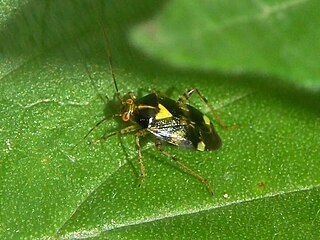
The Miridae are a large and diverse insect family at one time known by the taxonomic synonym Capsidae. Species in the family may be referred to as capsid bugs or "mirid bugs". Common names include plant bugs, leaf bugs, and grass bugs. It is the largest family of true bugs belonging to the suborder Heteroptera; it includes over 10,000 known species, and new ones are being described constantly. Most widely known mirids are species that are notorious agricultural pests that pierce plant tissues, feed on the sap, and sometimes transmit viral plant diseases. Some species however, are predatory.

Leptopterna dolabrata, commonly known as the meadow plant bug, is an insect in the Miridae family. It is commonly found in grassy areas in almost all of Europe to the northern Mediterranean and east across Asia Minor to the Caspian Sea region. It is an adventive species in North America. It feeds on developing grass seeds, causing seed heads to shrivel and prematurely whiten. It is regarded as a pest wherever grass is grown for seed. The species has long antennae and is black coloured.

Liocoris tripustulatus or the common nettle bug is a species of plant bug belonging to the family Miridae, subfamily Mirinae. The species was first described by Johan Christian Fabricius in 1781.

Lygus pratensis is a species of plant bugs belonging to the family Miridae.

Macrotylus quadrilineatus is a species of plant bug belonging to the family Miridae, subfamily Phylinae.

Lygus gemellatus is a species of plant-feeding insects in the family Miridae.

Polymerus is a genus of plant bugs in the family Miridae. There are at least 100 described species in Polymerus.

Closterotomus ventralis is a species of plant bugs belonging to the family Miridae, subfamily Mirinae.

Horistus is a genus of plant bugs belonging to the family Miridae, subfamily Mirinae.
Macrotylus vanduzeei is a species of plant bug in the family Miridae. It is found in North America.
Lidopus is a genus of jumping tree bugs in the family Miridae. There are at least two described species in Lidopus.

Isometopinae is a subfamily of jumping tree bugs in the family Miridae and are the only members of the Miridae to possess ocelli. The subfamily is split into five tribes. There are 42 genera and approximately 239 described species in Isometopinae.

Cremnorrhinini is a tribe of plant bugs in the family Miridae. There are about 9 genera and 16 described species in Cremnorrhinini.
Teleorhinus cyaneus is a species of plant bug in the family Miridae. It is found in North America.

Prepops is a genus of plant bugs in the family Miridae. There are at least 190 described species in Prepops.
Teleorhinus is a genus of plant bugs in the family Miridae. There are about eight described species in Teleorhinus.

Ceratocapsini is a tribe of plant bugs in the family Miridae. There are about 7 genera and at least 80 described species in Ceratocapsini.

Polymerus unifasciatus is a species of plant bug in the family Miridae. It is found in Europe & Northern Asia, North America, and Southern Asia.

Neolygus is a genus of plant bugs in the family Miridae. There are at least 110 described species in Neolygus.

Leucophoropterini is a tribe of plant bugs in the family Miridae. There are at least two genera and about ten described species in Leucophoropterini.
















